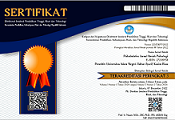Gambaran Problematic Smartphone Use Pada Remaja
Abstract
Penggunaan smartphone di zaman sekarang ini banyak memberikan manfaat pada berbagai aspek kehidupan. Hanya saja penggunaan smartphone yang berlebihan dapat berpotensi mengalami problematic smartphone use. Adapun rentang usia yang paling banyak mengalami problematic smartphone use adalah usia remaja. Problematic smartphone use merupakan ketidakmampuan untuk mengontrol penggunaan smartphone yang memungkinkan menjadi masalah sosial dan kesulitan dalam performa aktivitas sehari-hari. Penelitian ini bertujuan untuk mengetahui gambaran problematic smartphone use pada remaja usia 12-18 tahun di Indonesia khususnya di Medan serta mengetahui variabel demografi apa saja yang memberikan kontribusi pada kemunculan problematic smartphone use. Problematic smartphone use diukur dengan menggunakan Smartphone Addiction Scale Short Version (SAS-SV) yang disusun oleh Kwon dkk dan telah diadaptasi serta dimodifikasi oleh Arthy dkk. Penelitian ini merupakan penelitian kuantitatif deskriptif, yang dilakukan pada sampel penelitian berjumlah 241 remaja, melalui convenience sampling denganpenyebaran kuesioner menggunakan aplikasi google form. Hasil penelitian menemukan bahwa problematic smartphone use pada remaja berada di kategori sedang dengan jumlah 201 orang (83%) untuk responden beberapa kota di Indonesia dan 130 orang (84%) untuk responden di kota Medan.Beberapa faktor personal seperti jenis kelamin, jumlah pengecekan smartphone per-hari, waktu penggunaan smartphone per-hari, dan alasan penggunaan smartphone berpotensi memberikan kontribusi pada kemunculan problematic smartphone use. Pendeteksian problematic smartphone useini sangat penting bagi remaja sebagai usaha pencegahan agar dapat terhindar dari perilaku bermasalah yang berdampak pada aspek fisik, sosial maupun emosional.
Keywords
Full Text:
PDFReferences
Agusta, D. (2016). Faktor-faktor resiko kecanduan menggunakan smartphone pada siswa di SMK negeri 1 Kalasan Yogyakarta. E-Journal Bimbingan dan Konseling, 5(3), 86–96. https://journal.student.uny.ac.id/ojs/index.php/fipbk/article/view/1021/909
Arthy, C.C., Effendy, E., Amin, M.M., Loebis, B.,Camellia, V & Husada, M.S. (2019). Indonesian version of addiction rating scale of smartphone usage adapted from Smartphone Addiction Scale-Short Version (SAS-SV) in junior high school. Macedonian Journal of Medical Sciences, 7(19), 3235-3239
Asosisi Penyelenggara Jasa Internet Indonesia (APJII). (2023). Profil Pengguna Internet Indonesia. Asosiasi Penyelengara Jasa Internet Indonesia (APJII). https://apjii.or.id/content/read/39/559/Hasil-Survei-Profil-Internet-Indonesia-2022
Asosisi Penyelenggara Jasa Internet Indonesia (APJII). (2020). Profil Pengguna Internet Indonesia. Asosiasi Penyelengara Jasa Internet Indonesia (APJII). https://survei.apjii.or.id/survei
Azwar, S. (2012). Penyusunan Skala Psikologi Edisi 2. Yogyakarta: Pustaka Belajar.
Bae, E. J., & Nam, S. H. (2023). How mothers’ problematic smartphone use affects adolescents’ problematic smartphone use: Mediating roles of time mothers spend with adolescents and adolescents’ self-esteem. Psychology Research and Behavior Management, 16, 885–892. https://doi.org/10.2147/PRBM.S401515
Balogun, F. M., & Olatunde, O. E. (2020). Prevalence and predictors of problematic smartphone use among pre-varsity young people in Ibadan, Nigeria. Pan African Medical Journal, 36, 1–13. https://doi.org/10.11604/pamj.2020.36.285.18858
Barkley, J. E. and Lepp, A. (2016). Mobile phone use among college students is a sedentary leisure behavior which may interfere with exercise. Computers in Human Behavior. 56, 29–33.
Busch, P. A., Hausvik, G. I., Ropstad, O. K., & Pettersen, D. (2021). Smartphone usage among older adults. Computers in Human Behavior, 121, 1–12. https://doi.org/10.1016/j.chb.2021.106783
Busch, P. A., & McCarthy, S. (2021). Antecedents and consequences of problematic smartphone use: A systematic literature review of an emerging research area. Computers in Human Behavior, 114, 1–47. https://doi.org/10.1016/j.chb.2020.106414
Chan, S. J., Yeo, K. J., & Handayani, L. (2023). Types of smartphone usage and problematic smartphone use among adolescents: A review of literature. International Journal of Evaluation and Research in Education, 12(2), 563–570. https://doi.org/10.11591/ijere.v12i2.22909
Chun, J. S. (2018). Conceptualizing effective interventions for smartphone addiction among Korean female adolescents. Children and Youth Services Review, 84, 35–39. https://doi.org/10.1016/j.childyouth.2017.11.013
Elhai, J. D., Yang, H., Fang, J., Bai, X., & Hall, B. J. (2020). Depression and anxiety symptoms are related to problematic smartphone use severity in chinese young adults: fear of missing out as a mediator. Addictive Behaviors, 101, 1–7. https://doi.org/10.1016/j.addbeh.2019.04.020
Fathya, R., Sari, K., & Mawarpury, M. (2020). Tingkat smartphone addiction pada penduduk di kota Banda Aceh. Jurnal Psikologi, 16(2), 202–215. https://doi.org/10.24014/jp.v14i2.9794
Fischer-Grote, L., Kothgassner, O. D., & Felnhofer, A. (2019). Risk factors for problematic smartphone use in children and adolescents: A review of existing literature. Neuropsychiatrie. 33(4), 179–190. https://doi.org/10.1007/s40211-019-00319-8
Fırat, S., Gül, H., Sertçelik, M., Gül, A., Gürel, Y., & Kılıç, B. G. (2018). The relationship between problematic smartphone use and psychiatric symptoms among adolescents who applied to psychiatry clinics. Psychiatry Research, 270, 97–103. https://doi.org/10.1016/j.psychres.2018.09.015
Hanum, Z. (2021). Kemenkominfo: 89% Penduduk Indonesia Gunakan Smartphone. Media Indonesia (online). https://mediaindonesia.com/humaniora/389057/kemenkominfo-89-penduduk-indonesia-gunakan-smartphone
Haro, B., Beranuy, M., Vega, M. A., Calvo, F., & Carbonell, X. (2022). Problematic smartphone use and gender differences in vocational education and training. Education XX1, 25(2), 271–290. https://doi.org/10.5944/educxx1.31492
Kildare, C. A., & Middlemiss, W. (2017). Impact of parents mobile device use on parent-child interaction: A literature review. Computers in Human Behavior, 75, 579–593. https://doi.org/10.1016/j.chb.2017.06.003
Kwon, M., Kim, D. J., Cho, H., & Yang, S. (2013). The smartphone addiction scale: Development and validation of a short version for adolescents. PLoS ONE, 8(12), 1–7. https://doi.org/10.1371/journal.pone.0083558
Lee, H., Kim, J. W., & Choi, T. Y. (2017). Risk factors for smartphone addiction in Korean adolescents: Smartphone use patterns. J Korean Med Sci, 32(10), 1674-1679. doi:10.3346/jkms.2017.32.10.1674
Lopez-Fernandez, O., Honrubia-Serrano, L., Freixa-Blanxart, M., & Gibson, W. (2014). Prevalence of problematic mobile phone use in British adolescents. Cyberpsychology, Behavior, and Social Networking, 17(2), 91–98. https://doi.org/10.1089/cyber.2012.0260
Maharani, D. P., Dewi, A. A. N. T. N., & Dewi, N. N. A. (2019). Pengaruh durasi penggunaan dan tingkat kecanduan smartphone terhadap kejadian forward shoulder posture pada remaja usia 16-18 tahun di SMA Negeri 2 Denpasar. Majalah Ilmiah Fisioterapi Indonesia, 7(2), 32–35
Marini, L., Hendriani, W., & Wulandari, P. Y. (2023). Optimizing the role of the family in prevention teen smartphone addiction through psychoeducation smartphone addiction to parents. Dinamisia : Jurnal Pengabdian Kepada Masyarakat, 7(4), 930–941. https://doi.org/10.31849/dinamisia.v7i4.15217
Nahas, M., Hlais, S., Saberian, C., & Antoun, J. (2018). Problematic smartphone use among lebanese adults aged 18–65 years using MPPUS-10. Computers in Human Behavior, 87, 348–353. https://doi.org/10.1016/j.chb.2018.06.009
Panji, A. (2014). Hasil Survei Pemakaian Internet Remaja Indonesia. Kompas. https://tekno.kompas.com/read/2014/02/19/1623250/Hasil.Survei.Pemakaian.Internet.Remaja.Indonesia
Papalia, E. D., & Feldman, R. T. (2014). Menyelami Perkembangan Manusia : Experience Human Development. Salemba Humanika
Park, J. H., & Park, M. (2021). Smartphone use patterns and problematic smartphone use among preschool children. PLOS ONE, 16(3), 1–12. https://doi.org/10.1371/journal.pone.0244276
Pereira, F. S., Bevilacqua, G. G., Coimbra, D. R., & Andrade, A. (2020). Impact of problematic smartphone use on mental health of adolescent students: Association with mood, symptoms of depression, and physical activity. Cyberpsychology, Behavior, and Social Networking, 23(9), 619–626. https://doi.org/10.1089/cyber.2019.0257
Pusparisa, Y. (2020). Pengguna Smartphone diperkirakan Mencapai 89% Populasi pada 2025. https://databoks.katadata.co.id/datapublish/2020/09/15/pengguna-smartphone-diperkirakan-mencapai-89-populasi-pada-2025
Ryding, F. C., & Kuss, D. J. (2020). Passive objective measures in the assessment of problematic smartphone use: A systematic review. Addictive Behaviors Reports, 11, 1–18. https://doi.org/10.1016/J.ABREP.2020.100257
Sadya, S. (2023). Pengguna Smartphone Indonesia Terbesar Keempat Dunia pada 2022. Data Indonesia. https://dataindonesia.id/digital/detail/pengguna-smartphone-indonesia-terbesar-keempat-dunia-pada-2022
Samaha, M. and Hawi, N. S. (2016). Relationships among smartphone addiction, stress, academic performance, and satisfaction with life. Computers in Human Behavior, 57, 321–325.
Sullivan, B. M., & George, A. M. (2023). The association of motives with problematic smartphone use: A systematic review. Journal of Psychosocial Research and Cyberspace, 17(1), 1–34. https://doi.org/10.5817/CP2023-1-2
Taufik, J. R., Tiatri, S., & Allida, V. B. (2021). Problematic smartphone use and problematic internet use: The two faces of technological addiction. Proceedings of the 1st Tarumanagara International Conference on Medicine and Health (TICMIH 2021), 2017–2022. https://doi.org/https://doi.org/10.2991/ahsr.k.211130.037
Wardani, A. S. (2016). Menilik Perkembangan Smartphone dari Masa ke Masa. Liputan 6. https://www.liputan6.com/tekno/read/2669811/menilik-perkembangan-smartphone-dari-masa-ke-masa
Wijanarko, K. S. (2014). Pengaruh nilai pelanggan terhadap kepuasan serta dampaknya terhadap loyalitas menggunakan smartphone Samsung Galaxy Series di Kota Palu. E-Journal Katalogis, 2(7), 34–36
DOI: http://dx.doi.org/10.24014/pib.v5i1.26477
Refbacks
- There are currently no refbacks.
Redaksi Psikobuletin: Buletin Ilmiah Psikologi
Publisher: Universitas Islam Negeri Sultan Syarif Kasim Riau
Jl. H.R. Soebrantas Km. 15.5 No. 155 Gedung Fakultas Psikologi UIN Sultan Syarif Kasim Riau Kel. Tuahmadani Kec. Tampan Pekanbaru - Riau 28293.
E-mail : psikobuletin@uin-suska.ac.id / Website :http://ejournal.uin-suska.ac.id/index.php/Psikobuletin
Psikobuletin : Buletin Ilmiah Psikologi by Fakultas Psikologi is licensed under a Creative Commons Attribution 4.0 International License.



31.png)





